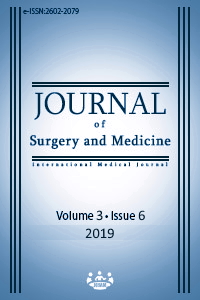Is insulin resistance associated with fatigue, the severity of the disease and motor disability in idiopathic Parkinson’s disease?
Keywords:
Fatigue, Idiopathic Parkinson’s disease, Insulin resistance, Motor disabilityAbstract
Aim: Abnormal glucose metabolism is known to potentially correlate abnormal mitochondrial function and neurodegenerative processes. The purpose of the study was to determine the association of insulin resistance on fatigue, the severity of the disease and motor disability in patients with idiopathic Parkinson’s disease (IPD).
Methods: A total of 50 patients diagnosed with IPD by a neurologist from university hospital were enrolled to study. Demographic characteristics (age, gender, height, weight and body mass index (BMI) were recorded. Patients were allocated into two groups by insulin resistance (IR), named insulin resistance (+) as group 1 (IR+) (n=30 (10 female, 20 male), age=66 years, height=169 cm, weight=75 kg, BMI=26.6 kg/m2 (median)) and insulin resistance (-) as group 2 (IR-) (n=20 (8 female, 12 male), age=63.5 years, height=168 cm, weight=75 kg, BMI=26.95 kg/m2 (median)). The Homeostatic Model Assessment of Insulin Resistance (HOMA-IR) test was used for assessment of insulin resistance. The disease severity was assessed by the Modified Hoehn and Yahr Scale, motor disability was assessed by Movement Disorders Society-revised Unified PD Rating Scale (MDS-UPDRS) and fatigue was rated by Fatigue Severity Scale (FSS).
Results: MDS-UPDRS scores were statistically significantly different between the groups of IPD patients with IR(+) and IR(-) (P=0.034). Modified Hoehn - Yahr (P=0.300) and FSS (P=0.147) scores were not statistically significantly different between the same groups.
Conclusion: This study suggests that IR may have a role for disease severity in patients with IPD. In patients with IPD, insulin resistance should be questioned and considered in the treatment and rehabilitation program.
Downloads
References
Kluger BM. Fatigue in Parkinson’s Disease. International Review of Neurobiology. 2017;133:743-68.
Olmos IA, Limousin P, Lees A, Foltynie T. Parkinson’s disease, insulin resistance and novel agents of neuroprotection. Brain. 2013;136:374–84.
Barat P, Meiffred MC, Brossaud J, Fuchs D, Corcuff JB, Thibault H, et al. Inflammatory, endocrine and metabolic correlates of fatigue in obese children. Psychoneuroendocrinology. 2016;74:158–63.
Gelb DJ, Oliver E, Gilman S. Diagnostic criteria for Parkinson disease. Arch Neurol. 1999;56:33-9.
Matthews DR, Hosker JP, Rudenski AS, Naylor BA, Treacher DF, Turner RC. Homeostasis model assessment: insulin resistance and beta-cell function from fasting plasma glucose and insulin concentrations in man. Diabetologia. 1985;28(7):412-9.
Goetz CG, Poewe W, Rascol O, Sampaio C, Stebbins GT, Counsel C, et al. Movement Disorder Society Task Force Report on the Hoehn and Yahr Staging Scale: Status and Recommendations. Movement Disorders. 2010;19(9):1020-8.
Goetz CG, Fahn S, Martinez-Martin P, Poewe W, Sampaio C, Stebbins GT, et al. Movement Disorder Society-sponsored revision of the Unified Parkinson's Disease Rating Scale (MDS-UPDRS): process, format, and clinimetric testing plan. Movement Disorders. 2007;22(1):41–7. doi: 10.1002/mds.21198.
Krupp LB, LaRocca NG, Muir-Nash J, Steinberg AD. The fatigue severity scale. Application to patients with multiple sclerosis and systemic lupus erythematosus. Arch. Neurol. 1989;46(10):1121–3.
Ulu MS, Yüksel Ş. Insulin Resistance. Kocatepe Medical Journal. 2015;16:238-43.
Friedman JH, Brown RG, Comella C, Garber CE, Krupp LB, Lou JS. Fatigue in Parkinson's disease: a review. Movement Disorders. 2007;22(3):297–308.
Van Hilten JJ, Weggeman M, Van der Velde EA, Kerkhof GA, Van Dijk JG, Roos RA. Sleep, excessive daytime sleepiness and fatigue in Parkinson's disease. J. Neural Transm. Park. Dis. Dement. Sect. 1993;5(3):235–44.
Krupp LB, Christodoulou C. Fatigue in multiple sclerosis. Curr Neurol Neurosci. 2001;1(3):294-8.
Lindqvist D, Kaufman E, Brundin L, Hall S, Surova Y, Hansson O. Nonmotor symptoms in patients with Parkinson’s disease: Correlations with inflammatory cytokines in serum. PLoS One. 2012;7(10):e47387.
Pavese N, Metta V, Bose SK, Chaudhuri KR, Brooks DJ. Fatigue in Parkinson’s disease is linked to striatal and limbic serotonergic dysfunction. Brain: A Journal of Neurology. 2010;133(11):3434–43.
Hashimoto M. Combined immunotherapy with “anti-insulin resistance” therapy as a novel therapeutic strategy against neurodegenerative diseases. Nature Partner Journals. 2017;3:4.
Bosso D, Plastino M, Cristiano D, Colica C, Ermio C, Bartolo M, et al. Dementia is associated with Insulin Resistance in patients with Parkinson's Disease. Journal of the Neurological Sciences. 2012;315:39–43.
Schelp AO, Mendes-Chiloff CL, Paduan VC, Corren JE, Vieria A, Nunes-Marchette JC, et al. Amnestic dementia impairment in Parkinson's disease: The role of body composition, ageing and insulin resistance. Clinical Nutrition ESPEN. 2017;20:47-51.
Nakatsuji H, Araki A, Hashizume A, Hikikata Y, Yamada S, Inagaki T, et al. Correlation of insulin resistance and motor function in spinal and bulbar muscular atrophy. J Neurol. 2017;264:839–47.
Ruiz-Arguelles A, Mendez-Huerta MA, Lozano CD, Ruiz-Arguelles GJ. Metabolomic profile of insulin resistance in patients with multiple sclerosis is associated to the severity of the disease. Multiple Sclerosis and Related Disorders. 2018;25:316–21.
Downloads
- 1667 2166
Published
Issue
Section
How to Cite
License
Copyright (c) 2019 Gökhan Özer, Hatice Adıgüzel, Zekiye İpek Katırcı Kırmacı, Nevin Ergun
This work is licensed under a Creative Commons Attribution-NonCommercial-NoDerivatives 4.0 International License.
















